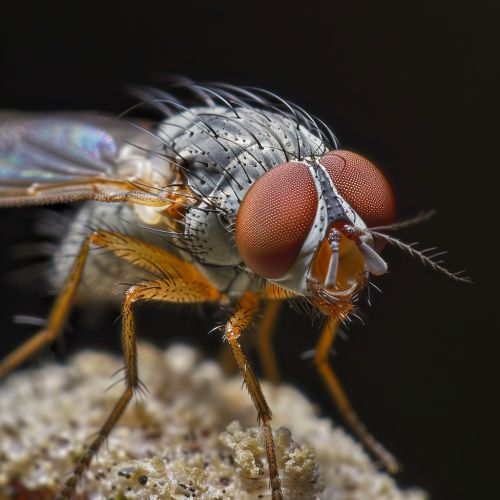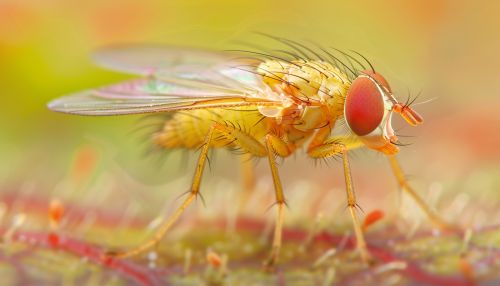Drosophila
Introduction
Drosophila is a genus of small flies, belonging to the family Drosophilidae, whose members are often called "fruit flies" or more appropriately pomace flies, vinegar flies, or wine flies, a reference to the characteristic of many species to linger around overripe or rotting fruit. They should not be confused with the Tephritidae, a related family, which are also called fruit flies (sometimes referred to as "true fruit flies"); tephritids feed primarily on unripe or ripe fruit, with many species being regarded as destructive agricultural pests, especially the Mediterranean fruit fly.
Biology and Lifecycle
The lifecycle of a Drosophila fly begins with the egg stage. The female Drosophila, like all insects, has two ovaries, each composed of a number of ovarioles, which are a type of assembly line for the production of eggs. Each ovariole is divided into a sequence of chambers, or follicles, each of which contains a single developing egg surrounded by a layer of nurse cells and a layer of follicle cells. The nurse cells produce yolk proteins and deliver them to the oocyte, which also contains the maternal contribution to the future zygote, the egg nucleus.


The egg hatches into larvae after about a day. The larvae feed on the medium in which they were hatched and undergo three stages of development, or instars. At the end of each instar, the larva molts, shedding its outer cuticle and forming a new one. After the third molt, the larva forms a pupa, during which it undergoes a complete metamorphosis that includes the formation of adult structures and the destruction of larval tissues. This process is controlled by a complex interplay of hormones. After several days, the adult fly emerges from the pupa.
Genetics
Drosophila flies are extensively used as model organisms in research for several reasons. They can be easily cultured in the lab, have a short generation time, and lay many eggs. The genome of Drosophila melanogaster has been sequenced and a large number of genetic tools are available for studying gene function in this organism. Furthermore, many genes in Drosophila are homologous to genes in humans, allowing researchers to study human diseases in this organism.
Drosophila has been used in genetics and biological research for over a century. The entire genome of Drosophila melanogaster was sequenced in 2000 by the Drosophila Genome Project. The genome sequence revealed approximately 14,000 genes on its four chromosomes. The Drosophila genome is very compact, with genes making up a much larger fraction of the total DNA than in many other organisms, such as humans.
Research Applications
Drosophila is commonly used in research because it can be easily and inexpensively cultured in the lab, has a short generation time, and lays many eggs. Drosophila research can be useful for studies of genetics, development, physiology, and behavior. Drosophila has been used in research for over a century and has been the subject of many Nobel Prizes.
Because of its extensive use in research, a wide variety of genetic tools and techniques have been developed for Drosophila: mutants, transposons, RNA interference (RNAi), and CRISPR are available for use in Drosophila. These tools can be used to manipulate genes and proteins in Drosophila, allowing researchers to study their functions.
